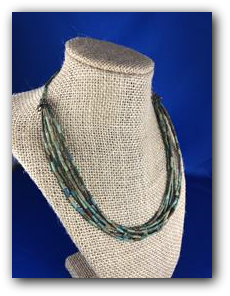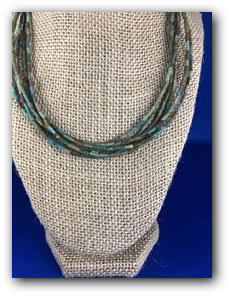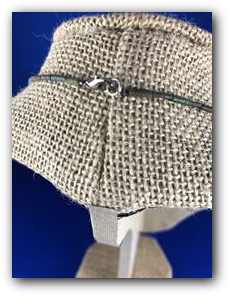
EGYPTIAN JEWELRY
ITEM#AB1058
Egyptian Faience Necklace, Late Dynastic Period , CA 1085-343 BCE
Egyptian Faience Necklace, Late Dynastic Period , CA 1085-343 BCE
Click any image top enlarge
Faience, a ceramic formed from a mixture of sand and quartz with additives for color, is considered to be the forerunner of true glass. It was used to produce beads for jewelry, as well as votive and utilitarian items. During firing, the added impurities migrated to the surface, creating the durable glaze and producing the beautiful colors it is so prized for. Large amounts of faience items were produced for funerary use as well, to accompany the departed into the afterlife. The greatest number of Egyptian beads were made of Faience, an inexpensive alternative to the precious stones they emulated, such as turquoise and lapis. Possibly invented in either Mesopotamia or Egypt, by 4000 BCE, Faience was the first mass produced synthetic material to simulate precious stones. The development of Faience, and eventually glass, satisfied the desire of the general populace to wear beads that emulated the precious stones of the wealthy.
AB1058 Late Dynastic Period, CA 1085-343 BCE $250
These ancient faience beads date from Egypt’s Late Dynastic period, approximately the 21st to 30th Dynasties. This necklace is comprised entirely of tubular and beads in a variety of rich blues, greens and earth tones. It begins as a single strand, then branching out to 6 separate strands for lots of drama and impact. The necklace is strung to a length 18" using modern materials, with a total bead length of almost 77 inches of beautiful, fine quality beads. Guaranteed ancient as described.
These ancient faience beads date from Egypt’s Late Dynastic period, approximately the 21st to 30th Dynasties. This necklace is comprised entirely of tubular and beads in a variety of rich blues, greens and earth tones. It begins as a single strand, then branching out to 6 separate strands for lots of drama and impact. The necklace is strung to a length 18" using modern materials, with a total bead length of almost 77 inches of beautiful, fine quality beads. Guaranteed ancient as described.














